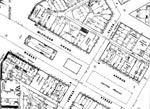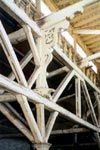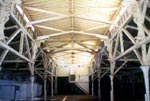| 
This 1884 insurance map shows the
Central Market area, including the vegetable hall and other shops.

Carved wooden ornamentation enhanced
the appearance of the market building.

After the market building was moved
to Belle Isle, it was converted to a riding stable. It had been
vacant for more than 20 years at the time of this photo.

Elegant joinery, supplemented by
elaborated carvings enhances the appearance of the timer frame.

The cast iron columns were made
to resemble stone in the lower section, and resemble wood above
the flared support.
|
|
The growth of the Central Market reflects Detroit’s growth
as a city. Much of Detroit’s early history revolved around
its importance as a port and strategic location in the Great Lakes.
During the 19th century, Detroit’s manufacturing base and
its population grew rapidly, more than doubling every ten years
from just 2,222 people in 1830 to 45,619 in1860. The Central Market
was the first Detroit market not located by the docks, reflecting
the city’s transition from a port town, to a city. Farmers
were now coming to Detroit to sell to city residents, rather than
to ship produce to eastern cities.
The Central Farmers Market began in 1843 as a simple shed built
off the rear of the old City Hall building. Problems with traffic
congestion caused by the market, along with the desire to make
the prominent square more presentable, led newly elected Mayor
Christian H. Buhl to pledge to build a new covered market building.
The city hired local architect John Schaffer to develop plans.
Schaffer’s design called for a “structure to be comprised
of forty-eight iron columns supporting a wooden roof, [measuring]
70 by 242 feet from outside to outside.” The construction
contract was awarded in June to Joel Gray at a cost of $5,312.
In late September of 1860, the Detroit Free Press wrote,
“The new market building in the rear of the City Hall
is nearly competed and promises to be a fine structure. It covers
the whole of the space occupied as a vegetable market, and consists
of an open shed, the roof of which is supported on iron columns
and a well-finished framework. The roof is of slate and cost
about $1,500. It is designed in time to make a tile floor and
erect fountains. The building will accommodate all the business
of the market and will constitute an ornament as well as a great
convenience to that important branch of city commerce.”
In its first year, the market earned the city $1,127 in rent,
covering 20% of the construction costs in one year. The building
thrived as the vegetable market through the 1880s. The emergence
of the Eastern Market, and the continuing desire to open the street
to traffic, led the Common Council to decide to close the Central
Market in 1892. In 1893 the Parks and Boulevards Commission, which
operated Belle Isle, received approval to move the building to
Belle Isle for use as a horse and vehicle shelter. The building
was re-erected on Belle Isle in 1894.
In later years it was converted to a riding stable – the
sides were bricked in, the roof was altered to add clerestory
windows to let in light, and an office and wash area was constructed
in the south end. After the riding stable closed in 1963, the
building was used to keep the horses of the Detroit Mounted Police,
and then later used for storage. It has been considered for demolition
since the early 1970s. Over the summer of 2003, the building was
dismantled and the parts from the original market building were
preserved for re-erection in Greenfield Village.
The Central Farmers Market is a rare and important building.
Because of fires and development pressures, wooden commercial
buildings, particularly timber-framed buildings, rarely survive
to the present in urban settings. This may be the only 19th century
timber-frame market building surviving in the United States. Its
move to Belle Isle saved it from demolition.
The building is architecturally significant. It is an excellent
expression of prevailing architectural tastes, as demonstrated
by the Free Press review. It captures the rapidly changing world
of building construction of the mid-19th century. The building
represents the pinnacle of the timber framer’s craft; it
is elegantly shaped and ornamented in a way that makes the frame
itself the visual keystone of the design. It was built shortly
before timber frame construction was eclipsed by the new balloon
frame construction, which used dimensional lumber and nailed joints.
The cast iron columns that support the timber-framed roof represent
the newest in manufactured construction materials. Cast iron was
the favorite material of the modern builder in the mid-19th century.
It was easy to form into a variety of shapes, and ideal for adding
ornamentation to buildings at a moderate cost. The columns in
the market building have been formed to represent two different
materials – the lower section resembles an elaborately carved
stone column, while the upper section looks like the timber frame
structure that it supports.
The building captures the exuberance and optimism of the city
of Detroit as it grew in its first wave from a frontier fort and
outpost, to an important city. A “useful and beautiful”
market building in the city’s central square was important
to this image of this growing city – as evidenced by the
fact that it took only nine months from Mayor Buhl’s inaugural
address of January 11, 1860 promising a new market building, to
its substantial completion. Few buildings survive from this first
era of growth in the city of Detroit.

Jim McCabe, Curator of Buildings
|

